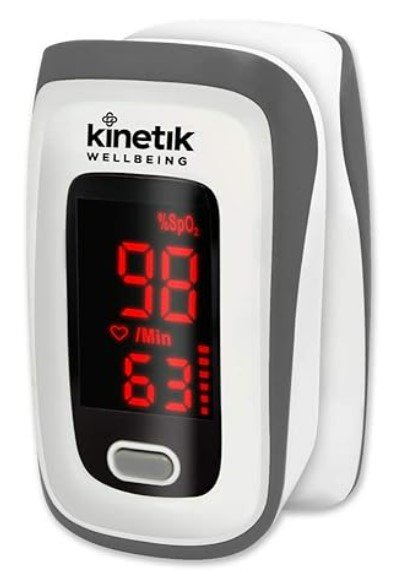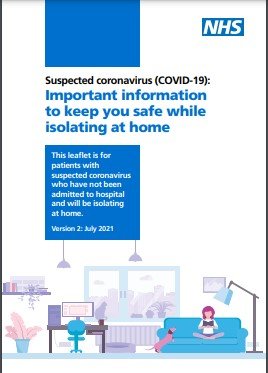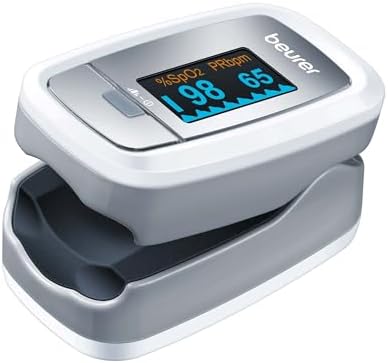
A pulse oximeter is a small, easy-to-use device that clips onto your finger to measure the amount of oxygen in your blood (SpO2) and your pulse rate. It’s like having a quick health check at your fingertips.
If you or someone in your family is dealing with a cough, cold, flu, or RSV, a pulse oximeter can help you monitor your health from home.
How Does a Pulse Oximeter Work?
A pulse oximeter shines a light through your finger to check the oxygen levels in your blood. It’s painless and takes only a few seconds. You get two important numbers: your blood oxygen level and your pulse rate. This information can help you decide if you need medical help or visit a hospital.
Why Use a Pulse Oximeter?
Pulse oximeters are affordable and incredibly useful for monitoring your health, especially when viruses like COVID-19, flu, or RSV are spreading. They’re a great tool at home to monitor your family’s health, particularly for older family members or anyone with breathing issues. If your oxygen levels drop below average, it’s a warning sign that you may need to seek medical attention.
Normal and Warning Readings
- Normal Readings: A healthy blood oxygen level usually ranges from 95% to 100%. If your reading is within this range, your body gets enough oxygen.
- Warning Readings: If your oxygen level falls below 92%, contact a healthcare professional by calling 111
- Danger Readings: Levels below 88% are considered dangerous, and you should immediately seek emergency care by calling 999.
When you first get a Pulse Oximeter, Do This
When you first get a pulse oximeter, use it with each family member so that you all know what your ‘normal’ readings are. Then, if you have to use it when you are sick, you can compare normal levels with those when you are ill. Doctors will be interested in the change in readings between normal and ill or change day-by-day.
Practical Tips for Accurate Pulse Oximeter Readings
- To get the most accurate readings from your pulse oximeter, ensure your hands are warm and relaxed. Remove nail polish or artificial nails, as these
- If you are concerned about your levels, take multiple readings at different times of the day. This can help you get a more accurate picture of your health.
- Make sure you are seated and relaxed for a few minutes before taking a reading. This helps ensure that your heart rate and oxygen levels are steady.
- Avoid wearing nail polish or artificial nails when using a pulse oximeter, as these can block the light and give an inaccurate result. If possible, use a finger without polish.
- If your hands are cold, warm them up by rubbing them or placing them in warm water. Cold fingers can make it harder for the pulse oximeter to get a proper reading.
- Keep your hand still while the pulse oximeter is measuring. Movement can cause the reading to be inaccurate.
- Ensure the pulse oximeter fits snugly but not too tight on your finger. A loose fit can interfere with the accuracy of the reading.
When to Use a Pulse Oximeter
A pulse oximeter can be particularly useful if you or a family member is recovering from COVID-19 or experiencing breathing problems. It helps you monitor whether your oxygen levels stay stable or drop, which could mean you need medical help. For anyone self-isolating with COVID-19, it’s a simple way to keep an eye on their health and act quickly if things change.
Follow NHS Guidance
The NHS recommends using a pulse oximeter if you have symptoms of COVID-19, especially if you’re at higher risk of severe illness. Following the current guidance on self-care and knowing when to seek help can make a big difference in managing your health.
Please download and keep this NHS key guidance on managing COVID-19

Above all, please download, print and keep handy this NHS leaflet with guidance for:
- what to do if you catch COVID-19
- self-isolation, which includes
- how to use your pulse oximeter
- normal oximeter warnings
- dangerous oximeter readings – when to get help.
Stay Empowered
Pulse oximeters are more than just a device—they’re a way to feel more in control of your health. By understanding your oxygen and pulse readings, you can make informed decisions about when to rest, call your doctor, and seek emergency care. It’s a small tool that can provide significant peace of mind for you and your family.
Helpful Resources
For more on how to use a pulse oximeter and what your readings mean, download these leaflets.
Pulse Oximeter Guides
Before looking at what Oximeters you could buy, here are some more sources of guidance on how and when to use them, created for:
- NHS and other videos created by doctors on how to use oximeters
- Oximeter guides in other languages
How can I choose the best Pulse Oximeter?
We advise you only buy a Pulse Oximeter that is ‘CE Marked’ and a Class 2B medical device- this shows that it meets a basic medical equipment safety and accuracy standard and can be sold in the European Union and United Kingdom.
Oximeters that say ‘for sports and recreation only’ don’t meet this standard and shouldn’t be used medically.
All the oximeters we list are CE marked [we have checked this by buying them and checking the documentation].
Over the past four years, we have noticed that more than 70% of buyers chose oximeters from businesses based in the UK or Europe to reassure themselves that they have been built and tested to European standards.
Best Buy Finger Pulse Oximeters – Kinetic, OxiPro, Beurer
- Kinetik are a UK-based business that sells a range of medical devices. They have a sponsorship deal with St John Ambulance, which is, I think, why they are the most popular choice we see on this website. People want a trusted brand when they buy these devices.
- OxiPro is UK-based and sells a range of medical devices. It stands out with its low oxygen alarm.
- Beurer is based in Germany. Their oximeter is the most solidly built of the three. It’s a bit like the Audi of oximeters.
What does a pulse oximeter measure?
Related Questions: what does pulse oximeter measure, what do pulse oximeters measure, what is pulse oximeter measure, what is pulse oximeter used to measure
Answer: A pulse oximeter measures two things: the oxygen level in your blood (often called SpO2) and your heart rate. Knowing your oxygen level is important, especially if you have a breathing condition like COVID-19, Flu, asthma or COPD, as it tells you how well oxygen is being delivered throughout your body.
Source: https://www.healthline.com/health/pulse-oximetry
Are pulse oximeters accurate?
Related Questions: are oximeters accurate, are pulse oximeter accurate, are cheap pulse oximeters accurate, how accurate are pulse oximeters, pulse oximeter accuracy
Answer: Most pulse oximeters are pretty accurate, usually within 2-3% of your actual blood oxygen level. However, the accuracy can depend on the quality of the device, how well it’s used, and factors like cold fingers or nail polish. For best results, use it on warm, clean fingers, and try to sit still while taking the reading.
Source: https://magazine.medlineplus.gov/article/getting-an-accurate-read-on-pulse-oximeters
What is a pulse oximeter used for?
Related Questions: what is pulse oximeter used for, what is pulse oximetry used for
Answer: A pulse oximeter is used to check how well oxygen is being carried in your blood. It’s especially helpful if you have a health condition that affects your breathing or heart, like asthma, COPD, or even COVID-19. It can help you know when to rest, adjust your medication, or seek medical attention if your oxygen levels drop too low.
Source: https://www.healthline.com/health/pulse-oximetry
Where should a pulse oximeter be placed?
Related Questions: where to place pulse oximeter on newborn, where to place pulse oximeter on baby
Answer: For adults, a pulse oximeter is usually placed on your fingertip, toe, or even your earlobe. It’s often put on their foot or hand for newborns and babies. The key is ensuring the area is warm, and there is good blood flow to get the most accurate reading.
Source: NHS England – Easy Read Guide on Pulse Oximeters: https://www.england.nhs.uk/coronavirus/wp-content/uploads/sites/52/2022/02/pulse-oximeter-easy-read-2022-digital.pdf
Does a pulse oximeter measure heart rate?
Related Questions:does pulse oximeter measure heart rate, does pulse oximeter check heart rate
Answer: Yes, a pulse oximeter measures your heart rate and the oxygen level in your blood. This can be very useful if you want to monitor your heart health and oxygen levels simultaneously.
Source: NHS – Pulse Oximetry Information: https://www.nhs.uk/conditions/coronavirus-covid-19/check-your-own-symptoms/how-to-use-a-pulse-oximeter/
How do pulse oximeters measure oxygen?
Related Questions:how does pulse oximeter measure oxygen, how do pulse oximeters determine oxygen levels, how does a pulse oximeter measure oxygen saturation, how does a pulse oximeter measure blood oxygen levels
Answer: A pulse oximeter uses light to measure how much oxygen is in your blood. It shines light through your skin and then detects how much of that light is absorbed by oxygenated blood versus deoxygenated blood. This information helps calculate your oxygen saturation level, giving you an idea of how well oxygen is being transported in your body.
Source: NHS – How to Use a Pulse Oximeter: https://www.nhs.uk/conditions/coronavirus-covid-19/check-your-own-symptoms/how-to-use-a-pulse-oximeter/
Which finger is best for using a pulse oximeter?
Related Questions:which finger is best for pulse oximeter, which finger is best for pulse oximeter reading
Answer: The best finger to use is usually the index or middle finger of your dominant hand. This is because these fingers typically have stronger blood flow, which helps the pulse oximeter get a more accurate reading. Just make sure your hands are warm and relaxed.
Source: NHS – Using a Pulse Oximeter: https://www.nhs.uk/conditions/coronavirus-covid-19/check-your-own-symptoms/how-to-use-a-pulse-oximeter/
What are the best pulse oximeter brands?
Related Questions:which oximeter is best, which pulse oximeter is the most accurate
Answer: You can scroll up to see which brands we recommend.
How does a pulse oximeter measure heart rate?
Answer: A pulse oximeter measures your heart rate by detecting the tiny changes in light that happen as your heart beats and pushes blood through your body. It uses sensors to pick up these changes and calculate your pulse rate.
Source: NHS – Pulse Oximetry Basics: https://www.nhs.uk/conditions/coronavirus-covid-19/check-your-own-symptoms/how-to-use-a-pulse-oximeter/
How to use a pulse oximeter correctly?
Related Questions:pulse oximeter how to use, finger pulse oximeter instructions
Answer: To use a pulse oximeter, sit down and relax for a few minutes before starting. Clip the device onto your index or middle finger, making sure your hand is warm and that there is good contact between the device and your skin. Stay still and breathe normally while the device takes its reading.
Source: NHS – Using a Pulse Oximeter: https://www.nhs.uk/conditions/coronavirus-covid-19/check-your-own-symptoms/how-to-use-a-pulse-oximeter/
How can I get a pulse oximeter right now?
Original Questions: where can I buy a pulse oximeter locally, are pulse oximeters available at pharmacies, which stores near me sell pulse oximeters, how quickly can I get a pulse oximeter, is it better to buy a pulse oximeter online or in-store
Answer: You can buy a pulse oximeter at most major pharmacies, such as Boots or Lloyds, and online through retailers like Amazon or the British Lung Foundation shop. If you need one urgently, check local pharmacy stock first.
Argos stock a good Oximeter, the Kinitek Wellbeing, and often have stock for same-day collection.
Some NHS services may also provide pulse oximeters on loan, particularly if you have a condition like COVID-19 that requires monitoring.
Source: scroll up.
Are there any free pulse oximeters available?
Original Questions: can I get a pulse oximeter from the NHS, are there any free pulse oximeters available
Answer: In some cases, the NHS provides pulse oximeters on loan if you have certain health conditions, such as COVID-19, which require monitoring of your oxygen levels at home.
You can check with 111, or your GP or local health service to see if you are eligible to receive one for free.
Eligibility may depend on how vulnerable you are, and where you live.



